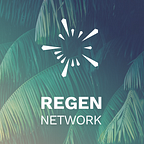How Regen is Creating an Eco-Friendly Blockchain
Let’s cut to the chase: for all the great environmental projects blockchain supports, it’s a well-known fact that the dominant blockchains, such as Bitcoin and Ethereum, are extremely energy-intensive.
Regen Network uses blockchain technology to ensure the immutability of important ecological data, and to govern the data commons that unifies currently siloed ecological intelligence into a unified and properly governed system. This allows for us to store Smart Contracts created between funders and farmers, and the GIS + remote sensing data that serve as algorithms for meeting ecological requirements within the Smart Contracts. Together, these two components function to automatically reward regenerative farmers meeting their contract criteria. The World Economic Forum calls blockchain a “foundational emerging technology of the Fourth Industrial Revolution,” and we agree — its potential to build a smoother, more efficient future is incredible.
But seeing as Regen Network’s entire mission is environmental, using energy-inefficient technology seems wrong…right?
Don’t worry — we have answers for you. Read on to see how our ledger stacks up against other popular blockchains like Ethereum and Bitcoin.
Cryptocurrency and Energy Use
First off, let’s break down why blockchain technology sucks up so much energy.
Cryptocurrency holds its novelty in the fact that its secure, transparent, and decentralized transactions rely on computer automation — rather than government or banks — to issue currency or process transactions. Every activity is recorded on the blockchain ledger in a “block,” and computer nodes make and process (or “mine”) these blocks, while tens of thousands of computers are all doing the same work at the same time.
For many, that’s the beauty of blockchain. Every single bit of information is permanently and immutably recorded, and will remain on the ledger forever (“secure”). This makes it easy to track activity (“transparent”), and authenticity can be verified by the entire user community rather than a single entity (“decentralized”).
Proof-of-Work is the benchmark “consensus” process for decentralized systems. These algorithms manage their difficulty based on a target block time production (10 minutes in Bitcoin). If all miners decided to switch back to laptops, the difficulty would plummet to almost nothing, and would use very little electricity. It is mining capacity active on the network that determines energy intensity in PoW systems.
What Makes Regen Ledger Different?
It’s all within the nodes.
Ethereum currently has about 14,000 nodes running. The Ethereum network currently uses approximately 20 terrawatt hours (TWh) per year. In fiscal year 2006, the US Department of Defense used almost 30,000 gigawatt hours (GWH) of electricity, at a cost of almost $2.2 billion. This is 30 TWh. On the other hand, Bitcoin uses 73 TWh/year at current hash rate — roughly equivalent to the energy usage of Austria.
Regen Ledger works a little differently. We plan to top out our system—which can execute ecological Smart Contracts and run Ecological State Protocols for every ecosystem around the globe—at just 100 nodes.
Yep — you read that correctly.
This is a difference of 13,900 total nodes in the system. 139x more energy is used by Ethereum than Regen Ledger, only to do 16x less work. This means that we will be 2,240x more energy efficient.
How is this achieved?
- Focusing solely on the domain-specific application of ecological state and contracting for ecological state
- Using hybrid Proof-of-Stake and Proof-of-Authority
- Limiting validator nodes in the system
- Running democratic governance of trusted parties to ensure network integrity
Regen Ledger will be governed by Regen Consortium, which will utilize a hybrid Proof-of-Stake, Proof-of-Authority system. Proof-of-Stake entails using tokens to back the consensus process, and Proof-of-Authority relies on the reputation of validators. Neither of these methods are energy-intensive.
We are also working on sharding, which will make the system more efficient still. For instance if we run 5 shards of the system, we see a 5x increase in transaction efficiency, which would lead Regen Network to be approximately 11,200x more efficient.
How are these currencies backed?
You might think of ETH as a currency backed by the work done by the Etheruem network, making it a commodity (trusted computing power) backed currency of sorts.
The US dollar is backed by the US military’s ability to maintain strategic control over petroleum reserves and force and/or encourage people to use USD to trade for petroleum, making it a commodity-backed reserve currency of sorts.
XRN (Regen’s native token) can be thought of as backed by the ecological knowledge and computation of the Regen Network, plus the ecological outcome utility of the network. This is essentially how knowledge’s utility value is measured by economists. Essentially, Regen Network’s value as a currency will be the value of human ability to stabilize the climate and regenerate ecosystems. This is equivalent to 9 gigawatts for the same amount of work that Ethereum currently does.
We are still working out the total computational power that will be needed to provide trusted ecological state monitoring and contracting capacity for the planet via Regen Network: but it NOT be on the order of magnitude of a country —it will be on the order of magnitude of a office building or a small town.
Devoting renewable energy to power a global computing network that focuses on ecological health and contracting, at a usage rate equivalent to a small town or an office building? Seems pretty reasonable to us.
